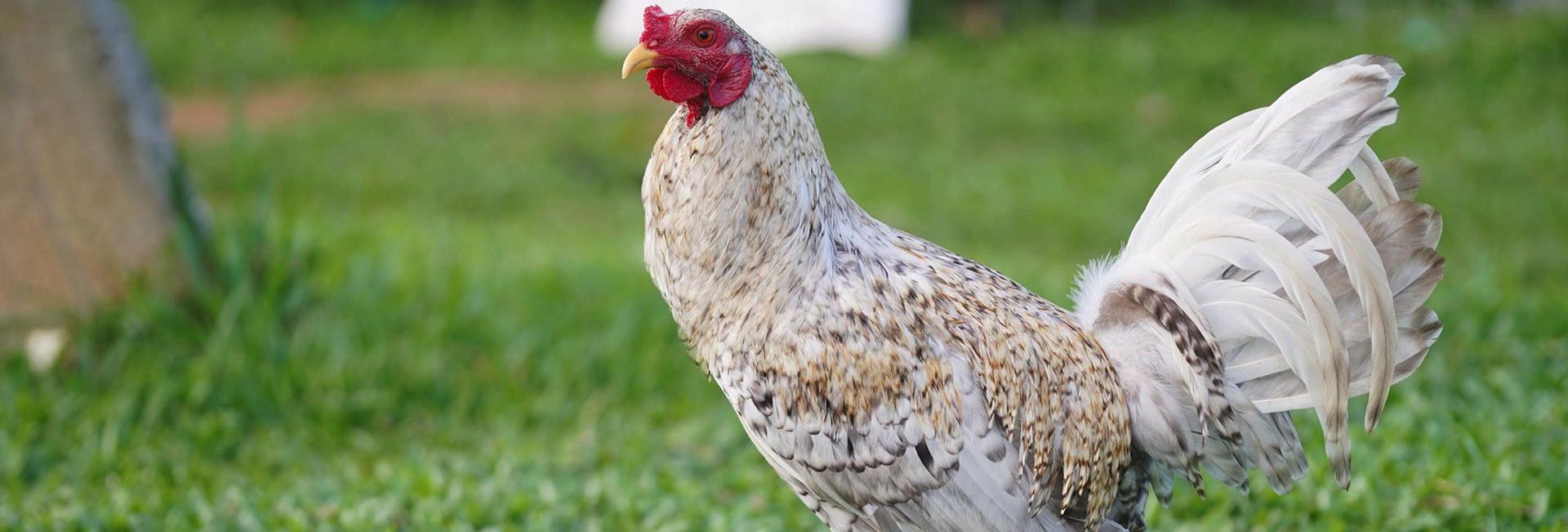Gamefowl Medical Care
Maintaining the health of your gamefowl is crucial for optimal performance, longevity, and overall well-being. Preventive care, including vaccinations and early detection of symptoms, plays a key role in disease management.
Understanding common viral and bacterial diseases, as well as parasitic infections, will help breeders effectively protect their gamefowl from illnesses that could hinder their development and performance. Below is an overview of some common diseases, their symptoms, affected areas, prevention methods, and recommended treatments.
Viral Diseases
FOWLPOX
SYMPTOMS: Characterized by lesions/scabs in the skin, cheesy like growth in the oral cavity.
AFFECT AREAS: Scabs in the skin and cheesy like growth in the oral cavity (wet type).
PREVENTION: Vaccination with Fowl Pox Vaccine must given to 18-day-old chick via wingweb.
TREATMENT: Antibiotics for secondary bacterial infection.
INFECTIOUS BRONCHITIS
SYMPTOMS: Characterized with bulging/swelling of the eyes with respiratory signs like flu and cough.
AFFECT AREAS: Mucus plug in the trachea and bifurcation of the posterior part of the trachea, bulging swollen eyes with mucus in the nasal cavity.
PREVENTION: Vaccination with IB vaccine must be given to 1-day and 12-day via intraocular or Intranasal.
TREATMENT: Antibiotics for secondary bacterial infection.
INFECTIOUS BRONCHITIS (Variant)
SYMPTOMS: Causes egg drop, soft shelled eggs and misshapen eggs, whitish diarrhea.
AFFECT AREAS: Reproduction system
PREVENTION: Vaccination with IB vaccine must be given to 1-day and 12-day via intraocular or Intranasal.
TREATMENT: Antibiotics for secondary bacterial infection.
INFECTIOUS BURSAL DISEASE (IBD) OR GUMBORO
SYMPTOMS: Characterized by ruffled feathers, whitish watery diarrhea. Common only to 4-months old and below chickens.
AFFECT AREAS: Petechial hemorrhages in the pectoral muscle, petechial hemorrhage in the proventricular-vetricular junction, inflammed or athropied bursa of fabricius
PREVENTION: Vaccination with IBD Vaccine (Oral). Classic and intermediate. Vaccine must be given to 1-day, 7-day and 21-day.
TREATMENT: Antibiotics for secondary bacterial infection.
INFECTIOUS LARYNGOTRACHEITIS (ILT)
SYMPTOMS: Characterized with coughing of blood, petechial hemorrhages in the trachea
AFFECT AREAS: Petechial hemorrhages in the inner lining of the trachea, swollen bulging eyes, blood plug in the trachea
PREVENTION: Vaccination with live or recombinant ILT Vaccine (Introcular or Intranasal)
TREATMENT: Antibiotics for secondary bacterial infection.
LYMPHOID LEUKOSIS
SYMPTOMS: Characterized by hurdle paralysis and blindness. Mostly hereditary. Adult birds are affected since it is like cancer in humans where tumor develop in time.
AFFECT AREAS: Neoplastic tumor growths in the liver spleen and bursa
TREATMENT: Antibiotics for secondary bacterial infection.
MAREKS
SYMPTOMS: Characterized by hurdle paralysis and blindness. Most adult birds are affected since it is like cancer in humans where tumor develop in time.
AFFECT AREAS: Discoloration of of eyes, inflamed sciatic nerves, multi systemic tumors.
PREVENTION: Vaccination with Mareks Vaccine must be given to day old chick via subcutaneous injection.
TREATMENT: Antibiotics for secondary bacterial infection.”
NEWCASTLE DISEASE
SYMPTOMS: Characterized by torticollis and greenish diarrhea.
AFFECT AREAS: Petechial hemorrhages in the proventriculus, Hemorrhagic intestines, Petechial hemorrhage in the ileocecal junction, Nasal Cavity
PREVENTION: Vaccination with NCD vaccine lasota, B1b1, Clon. Vaccine must be given to 1-day, 12-day, 24-day chicks and then repeat every 6 months for booster through intraocular or intranasal.
TREATMENT: Antibiotics for secondary bacterial infection.”
BACTERIAL DISEASES
CHRONIC RESPIRATORY DISEASE (CRD) OR MYCOPLASMA
SYMPTOMS: Characterized by ILT, IB and Coryza (respiratory signs)
AFFECT AREAS: Presence of mucus in the oronasal cavity, thickening of the air sacs with bubble like and cheesy-like exudates, Arthritis
PREVENTION: Vaccination with Live or Killed Mycoplasma gallisepticum bacterin must be given to 45-day chick via Intraocular, subcutaneous or intramuscular.
TREATMENT: Tylosin, macrolides
CORYZA
SYMPTOMS: Characterized by swollen face with foul smelling nasal mucus discharge.
AFFECT AREAS: Foul smelling mucus discharge in the nasal cavity.
PREVENTION: Vaccination with Killed Coryza Vaccine must be given to 35-day old chick via intramuscular or subcutaneous injection.
TREATMENT: Streptomycin, Dihydrostreptomycin, Sulphonamides, Tylosin, Erythromycin
FOWL CHOLERA
SYMPTOMS: Characterized by yellowish foul odored diarrhea, sudden acute deaths. Common to adult birds.
AFFECT AREAS: Inflamed comb and wattles, cyanosis of the head, discoloration of the liver, enteritis, swollen joints.
PREVENTION: Vaccination with Fowl Cholera, Killed Vaccine.
TREATMENT: Sulfonamides, Quinolones
FOWL TYPHOID/SALMONELLOSIS
SYMPTOMS: Characterized by pasty vent, whitish watery diarrhea.
AFFECT AREAS: Enteritis, ballooning of the intestines.
TREATMENT: Sulphonamides, Neomycintetracyclines, Amoxycillin, Fluoroquinolones
PROTOZOAL DISEASES
AVIAN MALARIA
SYMPTOMS: Characterized by greenish diarrhea, pale face with signs of wasting.
AFFECT AREAS: Enlarged liver and kidney, often black or dark colored
TREATMENT: Chloroquine, Sulfamides
COCIDIOSIS
SYMPTOMS: Characterized by bloody diarrhea. Common to young birds below 4 months of age.
AFFECT AREAS: Swollen cecum with presence of blood, hemorrhage in the lining of the cecum.
PREVENTION: Vaccination with Coccidiosis vaccine (Coccivacc)
TREATMENT: Pilmico Animal Health Toltrazuril 2.5%
OTHER MEDICATION/TREATMENTS
DIGESTIVE FORM OF DISEASES
GENERIC: Sulfa based antibiotics
PILMICO: Moxilisitin; Enfloxcin 100 (available 4/18)
RESPIRATORY
GENERIC: Penicillin, Macrolides
PILMICO: Moxilisitin; BIO B12 it comes in 20g pack size ideal for backyard operation; Losin MSP (available 4/18)
FUNGAL
GENERIC: Miconazole
PARASITIC
GENERIC: Internal – Praziquantel, albendazole; External – permethrins
PILMICO: Virbamec LA

